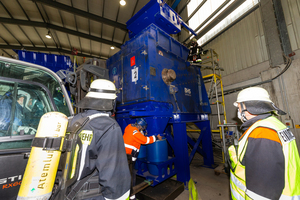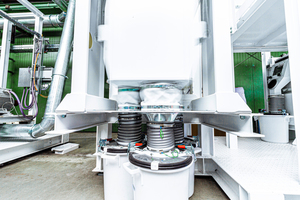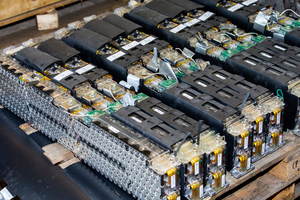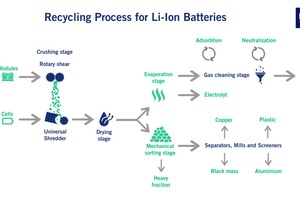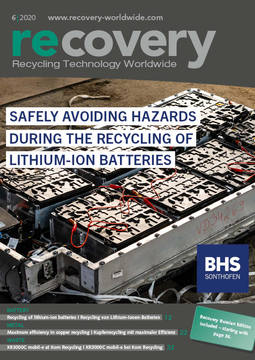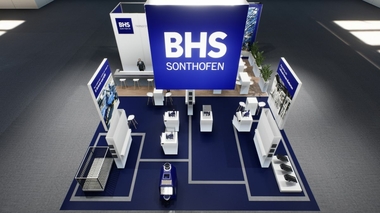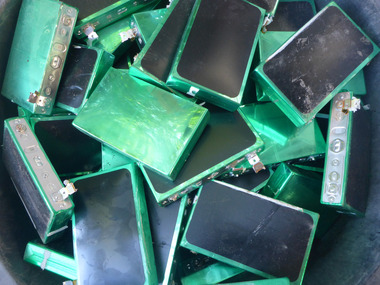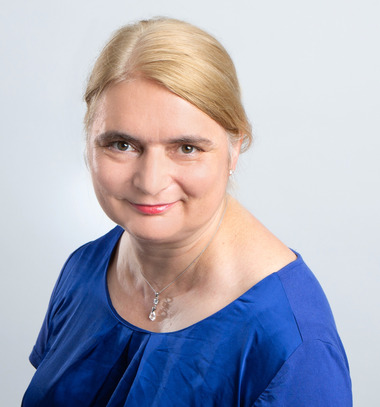Safely avoiding hazards during the recycling of lithium-ion batteries
BHS-Sonthofen is refining their innovative process for the recycling of spent batteries. It reliably prevents fires and the release of hazardous gases, as the crusher process is kept gas-tight all the way until the dryer, which is where the electrolytes are evaporated. This process is suitable for automobile batteries as well as lithium-ion and other household batteries. The resulting products are ready to be sold.
Crushing batteries spark-free
The input material is passed through a sluice to the gas-tight area before beginning the first process stage – crushing the battery. In the protective atmosphere, either one or two crushers are used: Single cell batteries and simple modules are ready to be processed further after one crushing stage, whereas larger batteries and battery packs as well as battery modules that have been screwed together undergo a two-stage crushing process. The BHS rotary shear of type VR handles the pre-shredding process. This slow-speed twin-shaft crusher crushes bulky batteries and battery packs reliably with its interlocking blades. The stainless steel screws and the steel connectors between the modules pose no danger thanks to the protective atmosphere.
The pre-crushed fraction or input material from simple battery modules and cells is brought to the target size in a single-shaft crusher during the main crushing step. The blade-equipped rotor of the BHS Universal Shredder of type NGU is perfectly suited for this stage.
Removing the dangers of electrolytes by vacuum
For further processing, a batch dryer (type HTC) from AVA is used. “The dryer plays an important role in our process,” explains Christian Kühn, Sales Director for Recycling & Environmental Technology at BHS-Sonthofen. “The electrolytes in the batteries can cause a fire. Furthermore, there are a lot of hazardous materials in the batteries. There is a risk of toxic dust explosions. We avoid these risks to people and the environment with the HTC and the protective atmosphere.”
There is a material buffer between the continuously operating Universal Shredder and the dryer – also in the system’s gas-tight area – for systems with larger capacities. After filling, the dryer applies a vacuum of around 400 millibars and slowly heats the input material to 110 °C. The gases escape via a vapor filter, followed by two condensation units: a shell-and-tube heat exchanger and a plate heat exchanger separate the electrolytes, which are then passed through a fat-bed reactor filled with milk of lime. A downstream activated carbon filter removes aromatized hydrocarbons from the exhaust air. The gas stream meets all legal requirements following this cleaning process.
Recovering valuable black mass
The crushed batteries are no longer hazardous after the drying phase. The remaining solid components are removed from the gas-tight area and passed through a dry mechanical sorting process. During this process, the fine black mass is screened. A zigzag sifter sorts the larger components into light and heavy fractions. The heavy fraction primarily contains coarse metallic materials that can be separated into ferrous and non-ferrous fractions with the help of eddy current separators and an overbelt magnet. The light fraction contains aluminum, copper, and plastic foils, as well as black mass. Another BHS crusher is used to recover as much of these valuable materials as possible: The rotor impact mill of type RPMX breaks down this fraction perfectly. Sifters and air separation systems sort the components further into black mass, plastics, and non-ferrous metals. The latter can then be further sorted and sold individually. The black mass is also ready to be sold.
The process from BHS might even be expanded in the future: “Our engineers are constantly working on refining the recycling process for batteries, in particular. We are currently testing concepts for discharging batteries and possibilities for further chemical treatment of the black mass,” reveals Christian Kühn.

